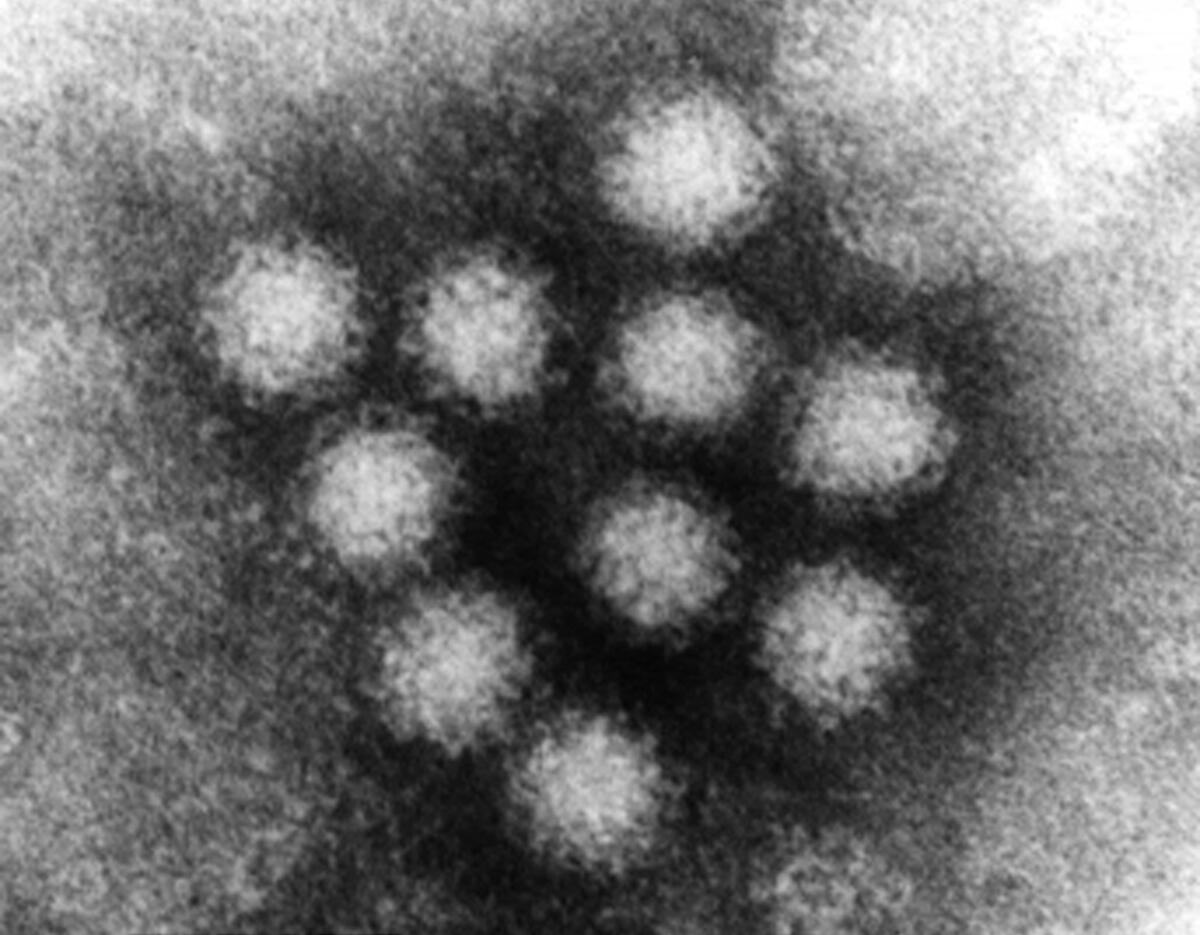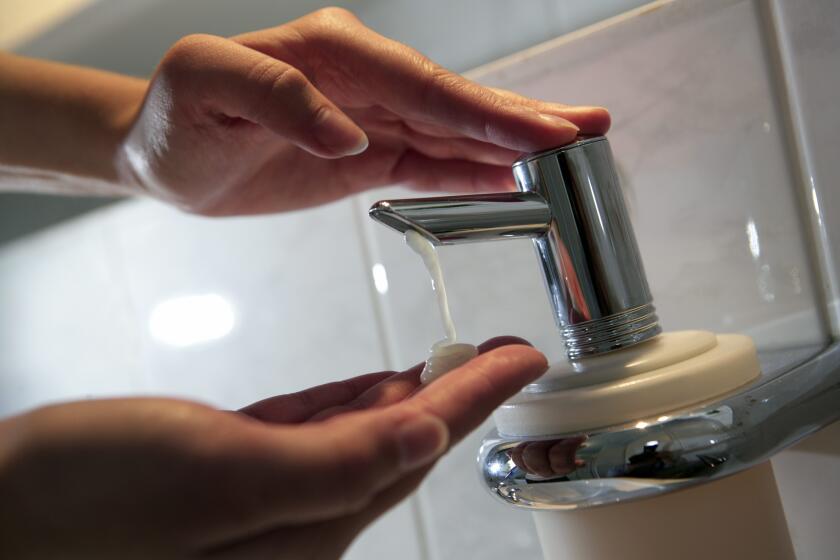As norovirus spreads in California, how can you protect yourself? Don’t rely on hand sanitizer

- Share via
The highly contagious norovirus, sometimes referred to as the stomach flu, is on the rise in California, prompting state health officials to urge healthcare providers to step up disinfection efforts in a bid to check the spread.
There have been at least 25 outbreaks of norovirus since Feb. 1, probably adding up to hundreds of cases statewide, according to a recent advisory from the California Department of Public Health.
They include several outbreaks at long-term-care facilities and one severe enough to force a Los Angeles County elementary school to temporarily close.
“Gastrointestinal outbreaks are often not confirmed by laboratory testing, so the true number of norovirus outbreaks likely well exceeds those confirmed by laboratory testing,” state health officials wrote in a March 28 advisory.
Illnesses at Carver Elementary were first reported to the Long Beach health department on Feb. 22. As many as 136 have reported illness.
Norovirus illness is sometimes referred to as a stomach bug or stomach flu, but it is unrelated to the flu, or influenza, which is a respiratory virus.

The EPA provided this undated electron beam micrograph showing a norovirus. The virus causes severe intestinal infections that can even be life-threatening in young children and the elderly.
The highly contagious norovirus causes diarrhea, vomiting, nausea and stomach pain. It can spread through direct contact with an infected individual, by consuming contaminated food or water, or when someone touches a contaminated surface and then puts unwashed hands into his or her mouth.
An example of such spread was recently seen at Carver Elementary School in Long Beach. Illnesses at the campus were first reported to health officials on Feb. 22, and by mid-March, 126 students and 10 staff members had reported “gastrointestinal symptoms,” according to a spokesperson with the Long Beach Department of Health and Human Services.
The school had to close for several days so officials could deep-clean the campus to control the outbreak.
In California, surveillance programs have shown “rising trends of norovirus concentrations detected in wastewater monitoring sites throughout the state, with large increases since mid-January,” according to the state public health department.
“To date, the trends at many California sites have not yet decreased to previous low levels, suggesting continued elevated norovirus disease activity in many areas,” the advisory states.
Two of your usual dinner companions aren’t in their seats, and when you look around at nearby tables you notice other empty seats too.
The trouble with norovirus is it can be hard to get a handle on. It can linger on surfaces for weeks, setting the stage for spread in crowded or highly trafficked areas where people are not regularly washing their hands or are more susceptible to infection. Such settings can include schools, child-care centers, healthcare facilities, cruise ships and nursing homes.
Although alcohol-based hand sanitizers can reduce germs on the skin in many circumstances, they are less effective in combating norovirus, according to the U.S. Centers for Disease Control and Prevention.
Many people aren’t aware that hand sanitizers do not work against norovirus. A suspected outbreak struck in 2018 during the Camp fire in Butte County at two evacuation centers, where staff members and evacuees didn’t know that hand-washing with soap and water — rather than using sanitizer — was required to control norovirus transmission, according to a report published by the CDC.
And a study published in the American Journal of Infection Control in 2011 found that long-term-care facilities where staff routinely used alcohol-based hand sanitizers — instead of soap and water — “might be associated with increased risk of norovirus outbreaks.”
Because of this, health officials say it’s important to wash your hands with soap and water for at least 20 seconds to help prevent transmission.
If people need to clean soiled areas, including vomit or diarrhea, officials say, it’s important to disinfect the area with a bleach-based household cleaner. One example could be using a chlorine bleach solution with five to 25 tablespoons of household bleach per gallon of water.
Federal officials have posted a list of special antimicrobial products that do work against norovirus,
To help prevent the spread of coronavirus, the CDC recommends washing your hands for 20 seconds, or “Happy Birthday” sung twice. Here are 10 way better songs to sing.
“Norovirus is highly contagious and can survive for weeks on surfaces and objects,” California health officials said in a statement. “Thorough disinfection while using personal protective equipment (PPE) should follow any patient seen for confirmed or suspected infection.”
Healthcare providers also should report suspected or confirmed outbreaks to health authorities, state officials said.
Increases in norovirus activity have been observed nationwide since mid-January.
The bulk of outbreaks happen from November through April, according to the CDC. In a typical year, the virus can cause 19 million to 21 million cases of vomiting or diarrhea, 109,000 hospitalizations and 900 deaths, mostly among seniors.
It typically takes half a day to three days from exposure to the onset of illness, which typically begins with an abrupt onset of nausea, vomiting, watery diarrhea and abdominal pain, state health officials said. People typically recover after two or three days.
With the longer, sunnier days of summer comes the crashing realization that you can now see with startling clarity just how filthy your home has become.
Doctors caution, however, that dehydration is a risk, and especially severe symptoms can occur in infants, immunocompromised individuals and older people, according to the CDC.
Food can be contaminated by small particles of feces or vomit from an infected person, including when tiny particles of vomit spray through the air.
Ill people who have recovered should still stay home from school or work for at least 48 hours after symptoms have ended, the state public health department said. People can be contagious with norovirus even a couple of days after they feel better.
According to the CDC, 61% of outbreaks involving diarrhea or vomiting are spread through contact like shaking hands or touching a dirty surface and then touching your mouth.
“Norovirus survives readily in the environment and is relatively resistant to common disinfectants. Therefore, norovirus can spread easily, particularly in closed and crowded settings, and can be challenging to control,” state officials said.
More to Read
Sign up for Essential California
The most important California stories and recommendations in your inbox every morning.
You may occasionally receive promotional content from the Los Angeles Times.



















